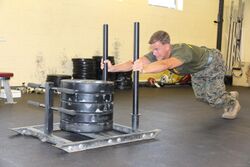Engineering:Training sled
A training sled, weight sled, or fitness sled is a piece of exercise equipment that provides resistance as the user pushes, pulls, or otherwise moves the sled along a flat surface.[1] Commercial sleds allow easily adjusting the weight or resistance and are supported on feet or wheels that allow moving the sled across surfaces such as grass, turf, or pavement without damage. Training with sleds has become increasingly popular since 2015, due in part to their availability in Crossfit gyms.[2][3] Sled pulling and sled pushing are commonly used forms of training for sprinting.[4]
Sled push
The sled push involves pushing the sled forward while facing the sled. It may be done at a variety of angles, such as upright, slightly bent forward, or with the body low and close to horizontal.[5] Sled pushes are roughly as effective as a barbell back squat for training the quadriceps, hamstrings, and core, with higher calf activity and lower activity in muscles near the spine.[6] The sled push also works the chest, arms, and shoulder muscles.[1]
Although sled pushing is a classic exercise,[7] athletic science has mainly focused on sled pulling, leaving sled pushing understudied.[4] One study found that the maximum velocity attainable during pushing decreases approximately linearly with total load, similarly to sled pulling, suggesting the analogous use of %Vdec to quantify load. This method of prescribing load first measures the velocity attained without any resistance, then adds weight so as to attain the target velocity which is the given percent less than the resistance-free velocity. For example, if the resistance-free velocity is 5 m/s, and the goal is 20% Vdec, one would add weight so as to achieve a velocity of 5*(1-20%)=4 m/s.[8] Another study found that complex training using sled pushing followed by sprinting improved sprint performance.[9]
Sled pull
The sled pull exercise involves attaching a harness or straps to the sled, or simply grabbing onto it. The user may walk forward, towing the sled, or face the sled and walk backwards while pulling the sled along.[5]
Several methods of prescribing load exist, such as an absolute weight, a percent of body mass (%BM), %Vdec, or the percent of maximum load movable a given distance without stopping or going below a specified velocity (%MRSL). The body-weight and absolute methods are simple but poor choices as they does not account for individual variation in strength or differences in surface friction.[10] Cahill et al. recommend the %Vdec method for general use.[4]
Sled pulling has been shown to improve sprint performance. Studies before 2014 used very light loads (<10% Vdec) to ensure sprint technique was unaffected, finding insignificant effects. More recent research has found that heavier loads are more effective in sprint training, although providing a disparate physical stimulus.[4] A wide range of loads, 10–30 %Vdec, has been shown to be effective.[10] Cahill et al. divide the loads as follows: <10% Vdec for technical high-speed training, <35% Vdec for training focusing on speed,[4] 48-52% Vdec for training power output,[11] and >65% Vdec for training focusing on strength.[4]
Other exercises
A lateral sled drag or pull involves dragging or pulling the sled while facing sideways. Sled rotations consist of turning the sled in place.[5] With a suspension strap, it is possible to do common upper body exercises such as rows, curls, presses, and reverse fly.[7]
References
- ↑ 1.0 1.1 Hopes, Sam (15 February 2023). "I did sled pushes every day for a week — here's what happened to my body" (in en). Tom's Guide. https://www.tomsguide.com/news/i-did-the-sled-push-every-day-for-a-week-heres-what-happened-to-my-body. "You [just need] something heavy that you can push along a flat surface."
- ↑ "The Exercise That Tones Your Butt And Thighs". Yahoo Life. 30 April 2015. https://www.yahoo.com/lifestyle/the-exercise-that-tones-your-butt-and-thighs-117650790432.html.
- ↑ Barisik, Yunus (6 December 2018). "Hate Jogging? Sled Walk Drills Are The Perfect Alternative". Stack. https://www.stack.com/a/hate-jogging-try-sled-walk-drills-instead/.
- ↑ 4.0 4.1 4.2 4.3 4.4 4.5 Cahill, Micheál J.; Cronin, John B.; Oliver, Jon L.; P. Clark, Kenneth; Lloyd, Rhodri S.; Cross, Matt R. (August 2019). "Sled Pushing and Pulling to Enhance Speed Capability". Strength & Conditioning Journal 41 (4): 94–104. doi:10.1519/SSC.0000000000000460. https://www.researchgate.net/publication/331054535.
- ↑ 5.0 5.1 5.2 Connor, Jenessa (12 June 2022). "This Sled Workout Has Everything to Better Your Fitness From All Angles". Yahoo Life. https://www.yahoo.com/lifestyle/sled-workout-everything-better-fitness-120000872.html.
- ↑ Maddigan, ME; Button, DC; Behm, DG (December 2014). "Lower-limb and trunk muscle activation with back squats and weighted sled apparatus.". Journal of Strength and Conditioning Research 28 (12): 3346–53. doi:10.1519/JSC.0000000000000697. PMID 25226330.
- ↑ 7.0 7.1 Kompf, Justin (23 September 2019). "10 Sled Exercises to Challenge Your Whole Body". stack. https://www.stack.com/a/10-sled-exercises-to-challenge-your-whole-body/.
- ↑ Cahill, Micheál J.; Oliver, Jon L.; Cronin, John B.; Clark, Kenneth P.; Cross, Matt R.; Lloyd, Rhodri S. (November 2021). "Sled-Push Load-Velocity Profiling and Implications for Sprint Training Prescription in Young Athletes". Journal of Strength and Conditioning Research 35 (11): 3084–3089. doi:10.1519/JSC.0000000000003294. PMID 31972825.
- ↑ Seitz, Laurent B.; Mina, Minas A.; Haff, G. Gregory (August 2017). "A sled push stimulus potentiates subsequent 20-m sprint performance". Journal of Science and Medicine in Sport 20 (8): 781–785. doi:10.1016/j.jsams.2016.12.074. PMID 28185808.
- ↑ 10.0 10.1 Petrakos, G; Morin, JB; Egan, B (March 2016). "Resisted Sled Sprint Training to Improve Sprint Performance: A Systematic Review.". Sports Medicine (Auckland, N.Z.) 46 (3): 381–400. doi:10.1007/s40279-015-0422-8. PMID 26553497.
- ↑ Cross, Matt R.; Brughelli, Matt; Samozino, Pierre; Brown, Scott R.; Morin, Jean-Benoit (September 2017). "Optimal Loading for Maximizing Power During Sled-Resisted Sprinting". International Journal of Sports Physiology and Performance 12 (8): 1069–1077. doi:10.1123/ijspp.2016-0362. PMID 28051333.
 |



